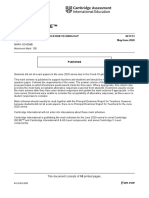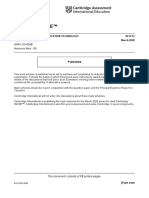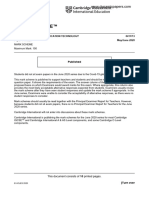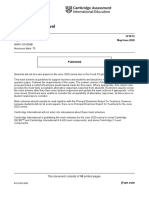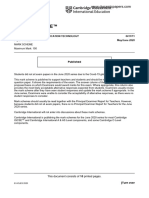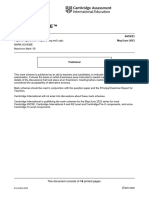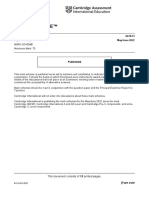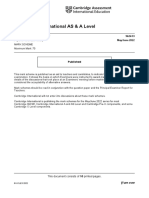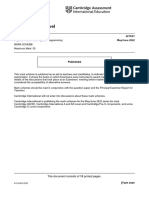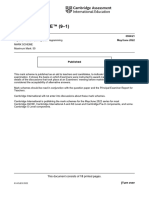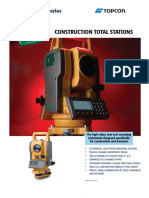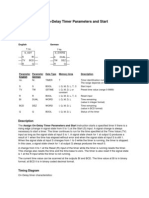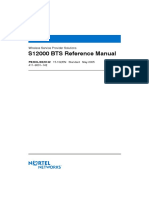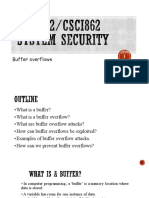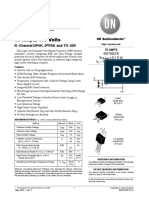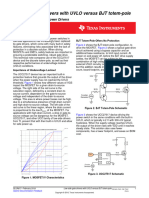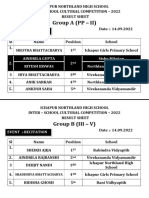Cambridge IGCSE™: Information and Communication Technology 0417/13 May/June 2022
Cambridge IGCSE™: Information and Communication Technology 0417/13 May/June 2022
Uploaded by
imran MalikCopyright:
Available Formats
Cambridge IGCSE™: Information and Communication Technology 0417/13 May/June 2022
Cambridge IGCSE™: Information and Communication Technology 0417/13 May/June 2022
Uploaded by
imran MalikOriginal Title
Copyright
Available Formats
Share this document
Did you find this document useful?
Is this content inappropriate?
Copyright:
Available Formats
Cambridge IGCSE™: Information and Communication Technology 0417/13 May/June 2022
Cambridge IGCSE™: Information and Communication Technology 0417/13 May/June 2022
Uploaded by
imran MalikCopyright:
Available Formats
Cambridge IGCSE™
INFORMATION AND COMMUNICATION TECHNOLOGY 0417/13
Paper 1 Theory May/June 2022
MARK SCHEME
Maximum Mark: 100
Published
This mark scheme is published as an aid to teachers and candidates, to indicate the requirements of the
examination. It shows the basis on which Examiners were instructed to award marks. It does not indicate the
details of the discussions that took place at an Examiners’ meeting before marking began, which would have
considered the acceptability of alternative answers.
Mark schemes should be read in conjunction with the question paper and the Principal Examiner Report for
Teachers.
Cambridge International will not enter into discussions about these mark schemes.
Cambridge International is publishing the mark schemes for the May/June 2022 series for most
Cambridge IGCSE, Cambridge International A and AS Level and Cambridge Pre-U components, and some
Cambridge O Level components.
This document consists of 15 printed pages.
© UCLES 2022 [Turn over
0417/13 Cambridge IGCSE – Mark Scheme May/June 2022
PUBLISHED
Generic Marking Principles
These general marking principles must be applied by all examiners when marking candidate answers. They should be applied alongside the
specific content of the mark scheme or generic level descriptors for a question. Each question paper and mark scheme will also comply with these
marking principles.
GENERIC MARKING PRINCIPLE 1:
Marks must be awarded in line with:
the specific content of the mark scheme or the generic level descriptors for the question
the specific skills defined in the mark scheme or in the generic level descriptors for the question
the standard of response required by a candidate as exemplified by the standardisation scripts.
GENERIC MARKING PRINCIPLE 2:
Marks awarded are always whole marks (not half marks, or other fractions).
GENERIC MARKING PRINCIPLE 3:
Marks must be awarded positively:
marks are awarded for correct/valid answers, as defined in the mark scheme. However, credit is given for valid answers which go beyond the
scope of the syllabus and mark scheme, referring to your Team Leader as appropriate
marks are awarded when candidates clearly demonstrate what they know and can do
marks are not deducted for errors
marks are not deducted for omissions
answers should only be judged on the quality of spelling, punctuation and grammar when these features are specifically assessed by the
question as indicated by the mark scheme. The meaning, however, should be unambiguous.
GENERIC MARKING PRINCIPLE 4:
Rules must be applied consistently, e.g. in situations where candidates have not followed instructions or in the application of generic level
descriptors.
© UCLES 2022 Page 2 of 15
0417/13 Cambridge IGCSE – Mark Scheme May/June 2022
PUBLISHED
GENERIC MARKING PRINCIPLE 5:
Marks should be awarded using the full range of marks defined in the mark scheme for the question (however; the use of the full mark range may
be limited according to the quality of the candidate responses seen).
GENERIC MARKING PRINCIPLE 6:
Marks awarded are based solely on the requirements as defined in the mark scheme. Marks should not be awarded with grade thresholds or
grade descriptors in mind.
© UCLES 2022 Page 3 of 15
0417/13 Cambridge IGCSE – Mark Scheme May/June 2022
PUBLISHED
Question Answer Marks
1 DVD RAM Drive 2
Memory stick
Question Answer Marks
2(a) Check digit 1
2(b) Length check 1
2(c) Presence check 1
2(d) Format check 1
Question Answer Marks
3 Two from: 2
Sensors
Keypad/Number pad
Touch screen
Microphone
Camera
Question Answer Marks
4(a) Three from: 3
Automatic backup
More storage
Difficult to lose the data as many copies are made of it
Many people can share access to the data
Can be accessed anywhere there is internet connection
Can be accessed from many devices
© UCLES 2022 Page 4 of 15
0417/13 Cambridge IGCSE – Mark Scheme May/June 2022
PUBLISHED
Question Answer Marks
4(b) Three from: 3
No control over data/security
Requires internet access
If the company goes out of business can lose data
If the internet crashes during sending or receiving then data could be lost
Many copies are made of the data which increases security issues
More expensive in the long run due to monthly charges
Question Answer Marks
5(a) Normal 2
Any seat from A1 to Z20//Any letter from A to Z inclusive followed by any number 1 to 20 inclusive
Abnormal
Any incorrect seat row or number/Any character other than A to Z and/or any number outside range 120 or anything that’s
incorrect
5(b) Five from: 5
Can be used for multiple elements
Fast access to additional information
Can be linked into a website
Can automatically link to email
The QR code is unique to the ticket
More robust than bar codes
Secure as the code cannot be swapped
© UCLES 2022 Page 5 of 15
0417/13 Cambridge IGCSE – Mark Scheme May/June 2022
PUBLISHED
Question Answer Marks
5(c) Eight from: 8
Advantages
The customer does not need an email address for the booking
The customer can pay by cash or electronic means whereas is an online system cards/apps are needed
Customers do not need an internet connection
More control of the booking therefore less errors for customers
Easier to cancel a booking once made
It is easier for the customer to gain information/help on the purchase
Disadvantages
Manual systems can result in double booking
Manual booking systems update the data less often than online systems
Difficult to see if a seat is taken as the seats are not updated when booked
Bookings can only be made when the booking office is open
Can only book at a booking office
People have to travel to the booking office to book, therefore wastes time
People have to travel to the booking office to book wastes cost
More difficult to change bookings
Physical tickets are issued which can be lost more easily
To gain full marks the discussion must have correct answers for both advantages and disadvantages
Question Answer Marks
6(a) Three from: 3
Staring at a computer screen for prolonged periods of time
Working in a room with poor lighting/Screen brightness too high/blue light of screen
Wrong setting on contrast
Glare from windows
Flickering screens
Dirty screens
Sitting too close to a screen
Text too small/font colour is contrasting with background/incorrect resolution/screen too small
© UCLES 2022 Page 6 of 15
0417/13 Cambridge IGCSE – Mark Scheme May/June 2022
PUBLISHED
Question Answer Marks
6(b) Four from: 4
Take regular breaks/look into the distance to relax the eyes/look at green objects
Use TFT/LCD/LED/flat screens to reduce the flicker
Use anti-glare screens/TFT/matt screens/window blinds to reduce the glare
Match the lighting in the room with the brightness of the computer screen
Turn the screens 90 degrees to the window to reduce the glare on the screen
Enable blue light filter/wear blue light glasses
Use night screen light on the computer
Have eyes tested regularly
Use a LED/LCD/flat screen monitor can reduce eye strain and headaches
Keep the screen clear of dust/dirt
© UCLES 2022 Page 7 of 15
0417/13 Cambridge IGCSE – Mark Scheme May/June 2022
PUBLISHED
Question Answer Marks
7(a) Eight from: 8
Advantages
No longer need to travel to the store so it saves the cost of travelling
No longer need to travel to the store so it saves the time of travelling
Saves time shopping as favourite lists can be produced
Saves time shopping around different stores
Wider range of shops
Customers can shop 24/7
Customers can compare the prices of different stores without travel
Shopping can take place using mobile devices anywhere there is an internet connection
Regular shopping schedules can be set up
Can see the physical objects in store and then have the advantages of shopping online
Disadvantages
Makes people lazy/lack of exercise
Over-reliance on computers
More security issues
Needs a reliable internet connection
Goods can take time to arrive
Goods could be damaged in transit
More chance of errors in the ordering
More difficult to amend an order after purchase
No way of checking the goods before buying
There may be delivery/packaging costs
To gain full marks the discussion must have correct answers for both advantages and disadvantages
7(b) Four from: 4
Bold colours/contrasting colours making it easier to read
Larger font sizes/clear font so it is easier for people reading the text
Simple navigation makes it easier to find the products
Larger buttons so they can be easily seen
Interactive screens/buttons/drop down menus to reduce typing
Larger bold heading to make it an easy to read layout
© UCLES 2022 Page 8 of 15
0417/13 Cambridge IGCSE – Mark Scheme May/June 2022
PUBLISHED
Question Answer Marks
8 Six from: 6
Similarities
Both have improved security by using encryption
Data cannot be read by eye so more secure
Data can be re-written
Direct data entry
Both allow fast access to the room
Both are read by a reader/scanner
Both can be easily damaged
Differences
RFID is contactless therefore has less wear and tear whereas magnetic is placed in reader
RFID reads the data faster
More data on RFID card
RFID cannot be left in the lock accidentally
RFID cards can be read by others from a distance using a device
Easier to clone a magnetic stripe card
Magnetic cards can only be read in one direction whereas RFID are only tapped
Magnetic stripe can be affected by magnets/mobile phones
RFID cards are more robust
To gain full marks the comparison must have correct answers for both similarities and differences
© UCLES 2022 Page 9 of 15
0417/13 Cambridge IGCSE – Mark Scheme May/June 2022
PUBLISHED
Question Answer Marks
9(a) Three from: 3
Internet protocol address
Assigned to your computer/NIC/device when it connects to a network
Uniquely identifies NIC/device on an IP network/unique number
Locates individual devices on a network/internet
Can show/indicate/track the physical location of the device
9(b) Three from: 3
The router creates data packets
The router receives the data packet
The data packet contains the destination/IP address
The router looks at the destination/IP address in the packet
The router uses its/has a routing table
Router compares the destination address in the packet with the addresses in its routing table
The router then determines the best route to the next router/network/destination
9(c) Four from: 4
It is needed for network security
It controls/checks the incoming and outgoing network traffic
A firewall is a barrier between a trusted secure internal network and the internet//network and the user
It can log incoming and outgoing traffic
It stops malicious traffic/cyber attacks/checks incoming data against criteria
It prevents computers connecting to unwanted sites
It prevents untrusted/un-recognised/un-authorised computers/users accessing data on the system
Protects data
Sends warnings/alerts the user
© UCLES 2022 Page 10 of 15
0417/13 Cambridge IGCSE – Mark Scheme May/June 2022
PUBLISHED
Question Answer Marks
10(a)(i) Two from: 2
Public access
Its world wide/International
Vast collection of computers and networks/network of networks/WAN/Wide Area Network
10(a)(ii) Two from: 2
Private network
Restricted access
Used in companies and organisations
Used to share internal documents, internal emails
Uses internet technology
10(b) Six from: 6
Vast amount of information
Faster to access information
Search engines allow the user to search quickly vast amounts of information
Information increases all the time
Its widely available
Allows users to meet other people/like minded people/communicate with friends over long distances
Easy for all people to use
Allows people to easily join specialist world wide groups
Allows social networking
Pages are hyperlinked so easier/quicker to find related pages
Allows online shopping/banking
Allows online up to date news, sports around the world/TV on demand
Allows interactivity, such as watching a video to see how to do a task/training aid
Helps vulnerable people to communicate with others
Allows people to be creative/make own websites
© UCLES 2022 Page 11 of 15
0417/13 Cambridge IGCSE – Mark Scheme May/June 2022
PUBLISHED
Question Answer Marks
11(a) Four from: 4
Load the image/photo editing software
Load/import the image
Click on image
Click on crop
Move arrows to select area to be cropped/Draw around the area to be cut out
Click on delete/Click outside the image
Select Save As/export and then select png format
11(b) Four from: 4
jpg is lossy format
Smaller file size
Joint photographic experts group
Loses quality when compressed
png is lossless format
Does not lose quality when compressed
Portable network graphics
© UCLES 2022 Page 12 of 15
0417/13 Cambridge IGCSE – Mark Scheme May/June 2022
PUBLISHED
Question Answer Marks
12(a) Four from: 6
Be careful of impersonators/people pretending to be officials
Safely dispose of personal information
Encrypt your data
Keep passwords private/Use a strong password
Don’t share personal data
Keep privacy settings high
Use security software/anti-spyware
Avoid phishing emails
Use a nickname/alias online
12(b) Four from: 4
For policed
Prevents illegal material being readily available
Prevents young children accessing unsuitable material
Ensures copyright laws are maintained
Stops extreme viewpoints from being seen
Prevents libelous text being added
Prevents hate comments/foul language/racial comments
Against policed
Governments block text/viewpoints/their own bias viewpoint
Unsuitable material is easily available in other ways
Control would cost money and users would have to pay
Control would be very difficult to enforce
Could cause less people to use it
Laws are different in each country but the internet is world wide
Creates a feeling of big brother/always being watched
To gain full marks the discussion must have correct answers for both for and against policed
© UCLES 2022 Page 13 of 15
0417/13 Cambridge IGCSE – Mark Scheme May/June 2022
PUBLISHED
Question Answer Marks
13 Four from: 4
Letters can be personalised for each student
The data is from the file therefore fewer errors
Saves time than typing in all the details each time
Letter can be saved and used again
Standard letter can be used each time/More consistency
Data in the database need only be checked
Easier to make changes to the letters
© UCLES 2022 Page 14 of 15
0417/13 Cambridge IGCSE – Mark Scheme May/June 2022
PUBLISHED
Question Answer Marks
14 Six from: 6
User telephones the bank telephone centre
System asks for the long number on the credit/debit card/sort code and account number/customer Access/ID number
The user taps out the number on the phone keypad and presses #/speaks the number
System asks for certain characters in a password/phone banking security number
The user taps out the characters asked for/security number and presses #
System checks the number is correct
System rejects the password/security number
The user re-enters the characters/security number
After three attempts the telephone connection drops
System asks other security answers
The user taps it in/speaks the answer
System asks which service you require/options given
Users tap in the number to select transfer from one account to another
System asks number of account transfer from
User taps in account number
System connects with the bank account
System asks for number of account transfer money to
User taps in account number
System asks amount to transfer
User taps in the amount
Checks the amount in the account/maximum not exceeded
Approves request
If amount exceeded the call is terminated/transaction declined/insufficient funds
System asks when the transfer should happen
The user taps in the date
System asks you to confirm it/sends a text message/send email
Customer hangs up to end the transaction
© UCLES 2022 Page 15 of 15
You might also like
- Instruction Manual HL2-105Document26 pagesInstruction Manual HL2-105Prince Vivek Kumar Singh100% (1)
- Moto g6 SchematicDocument34 pagesMoto g6 SchematicMarko0% (1)
- 12c RAC Administration PDFDocument470 pages12c RAC Administration PDFamalkumar100% (3)
- Draft Maths SNC (6-8) PDFDocument87 pagesDraft Maths SNC (6-8) PDFabidishaq5558100% (1)
- Cambridge IGCSE™: Information and Communication Technology 0417/13 May/June 2022Document15 pagesCambridge IGCSE™: Information and Communication Technology 0417/13 May/June 2022Tlhokomelo SetholeNo ratings yet
- Cambridge IGCSE™: Information and Communication Technology 0417/13 May/June 2022Document15 pagesCambridge IGCSE™: Information and Communication Technology 0417/13 May/June 2022ilovefettuccineNo ratings yet
- Cambridge IGCSE™: Information and Communication Technology 0417/12 May/June 2022Document15 pagesCambridge IGCSE™: Information and Communication Technology 0417/12 May/June 2022phyu01.ygnNo ratings yet
- Cambridge IGCSE™: Information and Communication Technology 0417/11Document11 pagesCambridge IGCSE™: Information and Communication Technology 0417/11wahajmohammed51No ratings yet
- Cambridge IGCSE™: Information and Communication Technology 0417/11Document9 pagesCambridge IGCSE™: Information and Communication Technology 0417/11Nisha S RajNo ratings yet
- Oct:nov 2022 P11Document10 pagesOct:nov 2022 P11qzpympdd9nNo ratings yet
- Cambridge IGCSE™: Information and Communication Technology 0417/11Document9 pagesCambridge IGCSE™: Information and Communication Technology 0417/11hamandishenicole3No ratings yet
- Cambridge IGCSE™: Information and Communication Technology 0417/13 May/June 2020Document10 pagesCambridge IGCSE™: Information and Communication Technology 0417/13 May/June 2020Harsh HarshNo ratings yet
- Cambridge IGCSE™: Information and Communication Technology 0417/12 February/March 2022Document10 pagesCambridge IGCSE™: Information and Communication Technology 0417/12 February/March 2022Tlhokomelo SetholeNo ratings yet
- Cambridge IGCSE™: Information and Communication Technology 0417/12 March 2020Document13 pagesCambridge IGCSE™: Information and Communication Technology 0417/12 March 2020Ahmad BatranNo ratings yet
- Cambridge IGCSE™: Information and Communication Technology 0417/11 May/June 2022Document14 pagesCambridge IGCSE™: Information and Communication Technology 0417/11 May/June 2022ilovefettuccineNo ratings yet
- Cambridge IGCSE ™: Information & Communication Technology 0417/13 October/November 2022Document9 pagesCambridge IGCSE ™: Information & Communication Technology 0417/13 October/November 2022vibinkings761No ratings yet
- Cambridge O Level: Computer Science 2210/11 May/June 2022Document13 pagesCambridge O Level: Computer Science 2210/11 May/June 2022Shaheer SheryNo ratings yet
- Cambridge IGCSE™: Computer Science 0478/11 May/June 2022Document13 pagesCambridge IGCSE™: Computer Science 0478/11 May/June 2022Tiyané ChigavaziraNo ratings yet
- Cambridge IGCSE™: Information and Communication Technology 0417/13 May/June 2020Document10 pagesCambridge IGCSE™: Information and Communication Technology 0417/13 May/June 2020eyadmohdsam09No ratings yet
- 0417 s20 Ms 13 MergedDocument263 pages0417 s20 Ms 13 Mergedeyadmohdsam09No ratings yet
- Cambridge IGCSE™: Information and Communication Technology 0417/12Document9 pagesCambridge IGCSE™: Information and Communication Technology 0417/12Ibrahim Abdi ChirwaNo ratings yet
- Cambridge IGCSE™: Information & Communication Technology 0417/11Document9 pagesCambridge IGCSE™: Information & Communication Technology 0417/11Rinoa HermanNo ratings yet
- Cambridge IGCSE™: Computer Science 0478/13Document10 pagesCambridge IGCSE™: Computer Science 0478/13Abraham AsifNo ratings yet
- 0417_w20_ms_12Document9 pages0417_w20_ms_12cenwesta1No ratings yet
- Cambridge O Level: Computer Science 2210/21Document18 pagesCambridge O Level: Computer Science 2210/21tashi docNo ratings yet
- Cambridge IGCSE™: Computer Science 0478/12 February/March 2022Document13 pagesCambridge IGCSE™: Computer Science 0478/12 February/March 2022REENA SNNo ratings yet
- Cambridge O Level: Computer Science 2210/12 May/June 2020Document10 pagesCambridge O Level: Computer Science 2210/12 May/June 2020Mashrur RahmanNo ratings yet
- Cambridge IGCSE™: Information and Communication Technology 0417/11 May/June 2020Document10 pagesCambridge IGCSE™: Information and Communication Technology 0417/11 May/June 2020Shafiq BhattiNo ratings yet
- Cambridge International AS & A Level: Computer Science 9618/31 May/June 2022Document11 pagesCambridge International AS & A Level: Computer Science 9618/31 May/June 2022Xcomwifi Private Business CorporationNo ratings yet
- Baseline Test Computer Science Grade 10 MSDocument10 pagesBaseline Test Computer Science Grade 10 MSdayanat8612No ratings yet
- Number 4 (0654 - w22 - Ms - 42)Document13 pagesNumber 4 (0654 - w22 - Ms - 42)Muhammad Luthfansyah PrabowoNo ratings yet
- Cambridge IGCSE™: Computer Science 0478/21Document18 pagesCambridge IGCSE™: Computer Science 0478/21Ase AqeNo ratings yet
- Cambridge IGCSE™: Information and Communication Technology 0417/13 October/November 2021Document9 pagesCambridge IGCSE™: Information and Communication Technology 0417/13 October/November 2021Tlhokomelo SetholeNo ratings yet
- Cambridge IGCSE™: Information & Communication Technology 0417/12 October/November 2021Document9 pagesCambridge IGCSE™: Information & Communication Technology 0417/12 October/November 2021EffNo ratings yet
- Cambridge IGCSE™: Computer Science 0478/13 May/June 2022Document13 pagesCambridge IGCSE™: Computer Science 0478/13 May/June 2022keiraNo ratings yet
- Cambridge O Level: Combined Science 5129/22 May/June 2022Document12 pagesCambridge O Level: Combined Science 5129/22 May/June 2022Kelvin SamatahNo ratings yet
- Cambridge IGCSE™: Computer Science 0478/13Document10 pagesCambridge IGCSE™: Computer Science 0478/13Arhamm JainNo ratings yet
- Cambridge IGCSE ™: Co-Ordinated Sciences 0654/42 October/November 2022Document13 pagesCambridge IGCSE ™: Co-Ordinated Sciences 0654/42 October/November 2022xuanquynhle03.95No ratings yet
- Cambridge Assessment International Education: Information and Communication Technology 0417/11 May/June 2018Document10 pagesCambridge Assessment International Education: Information and Communication Technology 0417/11 May/June 2018SimonaNo ratings yet
- Cambridge IGCSE™: Information and Communication Technology 0417/13 May/June 2021Document10 pagesCambridge IGCSE™: Information and Communication Technology 0417/13 May/June 2021AditiNo ratings yet
- Cambridge IGCSE™: Computer Science 0478/12 May/June 2020Document10 pagesCambridge IGCSE™: Computer Science 0478/12 May/June 2020SF GohNo ratings yet
- Cambridge IGCSE ™: Information and Communication Technology 0417/12Document9 pagesCambridge IGCSE ™: Information and Communication Technology 0417/12muhongyakennethNo ratings yet
- Cambridge International AS & A Level: Information Technology 9626/32 May/June 2022Document10 pagesCambridge International AS & A Level: Information Technology 9626/32 May/June 2022Muhammad MuddassirNo ratings yet
- 0478 m22 Ms 12....Document13 pages0478 m22 Ms 12....agentm398No ratings yet
- Cambridge O Level: Computer Science 2210/11Document12 pagesCambridge O Level: Computer Science 2210/11olgamantiziba2022No ratings yet
- Cambridge IGCSE ™: Information & Communication Technology 0417/11Document9 pagesCambridge IGCSE ™: Information & Communication Technology 0417/11eyadmohdsam09No ratings yet
- Cambridge IGCSE™: Information and Communication Technology 0417/13Document9 pagesCambridge IGCSE™: Information and Communication Technology 0417/13pranavjain966No ratings yet
- Cambridge IGCSE ™: Information & Communication Technology 0417/13 October/November 2022Document9 pagesCambridge IGCSE ™: Information & Communication Technology 0417/13 October/November 2022Tanay ModyNo ratings yet
- Cambridge IGCSE™: Information and Communication Technology 0417/12 May/June 2020Document9 pagesCambridge IGCSE™: Information and Communication Technology 0417/12 May/June 2020Black YoshiNo ratings yet
- Cambridge IGCSE™: Computer Science 0478/12 May/June 2022Document13 pagesCambridge IGCSE™: Computer Science 0478/12 May/June 2022Ora MattNo ratings yet
- Cambridge IGCSE™: Information and Communication Technology 0417/11 May/June 2020Document10 pagesCambridge IGCSE™: Information and Communication Technology 0417/11 May/June 2020Harsh HarshNo ratings yet
- Cambridge International AS & A Level: Information Technology 9626/33 May/June 2022Document10 pagesCambridge International AS & A Level: Information Technology 9626/33 May/June 2022Muhammad MuddassirNo ratings yet
- June 2022 Mark Scheme Paper 21Document13 pagesJune 2022 Mark Scheme Paper 21muqaddusmuzammil.21No ratings yet
- 9618 - w22 - Ms - 21 Computer ScienceDocument10 pages9618 - w22 - Ms - 21 Computer SciencekaisengweniNo ratings yet
- Cambridge IGCSE™: Information and Communication Technology 0417/11 May/June 2021Document9 pagesCambridge IGCSE™: Information and Communication Technology 0417/11 May/June 2021wasdNo ratings yet
- June 2022 Mark Scheme Paper 51Document9 pagesJune 2022 Mark Scheme Paper 51adannaajaegboNo ratings yet
- 0610 m22 Ms 32 PDFDocument11 pages0610 m22 Ms 32 PDFsolihinNo ratings yet
- Cambridge IGCSE™: Combined Science 0653/52 March 2020Document8 pagesCambridge IGCSE™: Combined Science 0653/52 March 2020Hin Wa LeungNo ratings yet
- Cambridge IGCSE™: Computer Science 0478/13 October/November 2020Document13 pagesCambridge IGCSE™: Computer Science 0478/13 October/November 2020boyredbisonNo ratings yet
- Cambridge O Level: Commerce 7100/23 May/June 2022Document21 pagesCambridge O Level: Commerce 7100/23 May/June 2022ahmedmujtabaNo ratings yet
- Cambridge IGCSE™: Accounting 0452/22 February/March 2022Document17 pagesCambridge IGCSE™: Accounting 0452/22 February/March 2022Janvi JainNo ratings yet
- Cambridge IGCSE™ (9-1) : Computer Science 0984/21 May/June 2022Document13 pagesCambridge IGCSE™ (9-1) : Computer Science 0984/21 May/June 2022rafaelnevanprayogoNo ratings yet
- Cambridge IGCSE™: Accounting 0452/21 May/June 2022Document14 pagesCambridge IGCSE™: Accounting 0452/21 May/June 2022lewisNo ratings yet
- VMWARE Certified Spring Professional Certification Concept Based Practice Questions - Latest EditionFrom EverandVMWARE Certified Spring Professional Certification Concept Based Practice Questions - Latest EditionNo ratings yet
- Hall Effect Viva Questions With AnswersDocument6 pagesHall Effect Viva Questions With AnswersSalman Ahmed25% (4)
- I-9403 Intelligent Sounder Strobe Installation and Operation Manual Issue 1.07Document4 pagesI-9403 Intelligent Sounder Strobe Installation and Operation Manual Issue 1.07Gaurang GoswamiNo ratings yet
- Material Culture - A Digital Documentation of The Art and CultureDocument13 pagesMaterial Culture - A Digital Documentation of The Art and Cultureharras lordNo ratings yet
- Fake Review Detection Iee PaperDocument4 pagesFake Review Detection Iee Paperapeksha SiddramNo ratings yet
- Assignment 1 - Part 2 Dataset B - Footballers' EarningsDocument3 pagesAssignment 1 - Part 2 Dataset B - Footballers' Earningsshaila islamNo ratings yet
- DTA100E DatasheetDocument7 pagesDTA100E DatasheetRichard SyNo ratings yet
- Topcon Serie GTS 100NDocument4 pagesTopcon Serie GTS 100Njonar leonesNo ratings yet
- Unit1-1 7 1-OperatingSystemsDocument7 pagesUnit1-1 7 1-OperatingSystemsShakila ShakiNo ratings yet
- S OdtDocument2 pagesS OdtlindembmNo ratings yet
- Nortel 12000 User ManualDocument236 pagesNortel 12000 User ManualMohamed NiyasNo ratings yet
- Week 5bDocument53 pagesWeek 5bThasleem ReyasNo ratings yet
- API PHP Package - MikroTik WikiDocument12 pagesAPI PHP Package - MikroTik Wikigustavito92012420945No ratings yet
- NGD15N41CL, NGB15N41CL, NGP15N41CL Ignition IGBT 15 Amps, 410 VoltsDocument11 pagesNGD15N41CL, NGB15N41CL, NGP15N41CL Ignition IGBT 15 Amps, 410 Voltsmarino246No ratings yet
- Cubasis 3 Beginners Guide - Mobile Music ProDocument54 pagesCubasis 3 Beginners Guide - Mobile Music ProdmzNo ratings yet
- Ordering SystemDocument3 pagesOrdering SystemJamil BatagaNo ratings yet
- Low-Side Gate Drivers With UVLO Versus BJT Totem-PoleDocument3 pagesLow-Side Gate Drivers With UVLO Versus BJT Totem-Poleachil de troyNo ratings yet
- Im34m6p14-01e 001Document626 pagesIm34m6p14-01e 001Il-Jin JeongNo ratings yet
- 2.1 Installation Requirements - . - . - . - . - . - . - . 3Document42 pages2.1 Installation Requirements - . - . - . - . - . - . - . 3Hugo Fernando SolisNo ratings yet
- Canon Ir 2545 Copier PDFDocument2 pagesCanon Ir 2545 Copier PDFIsaac Musiwa BandaNo ratings yet
- Mini Hi-Fi System: Owner'S ManualDocument41 pagesMini Hi-Fi System: Owner'S Manualdysan 45No ratings yet
- Ichapur Northland High School (Result Sheet)Document7 pagesIchapur Northland High School (Result Sheet)SounikNo ratings yet
- BetastarDocument66 pagesBetastarSamuel MorenoNo ratings yet
- Configuring MAC Address Tables: Information About MAC AddressesDocument6 pagesConfiguring MAC Address Tables: Information About MAC AddressesearespNo ratings yet
- Bill of Material PDFDocument79 pagesBill of Material PDFK.Rama KrishnaNo ratings yet
- LabVIEW Core 3 Online Day 1 ExercisesDocument54 pagesLabVIEW Core 3 Online Day 1 ExercisesSarfrazAnwar100% (1)
- Pimsleur French Level 1 CD Learn To Speak and Understand French With Pimsleur Language Programs Col PDFDocument5 pagesPimsleur French Level 1 CD Learn To Speak and Understand French With Pimsleur Language Programs Col PDFBrandy0% (2)











